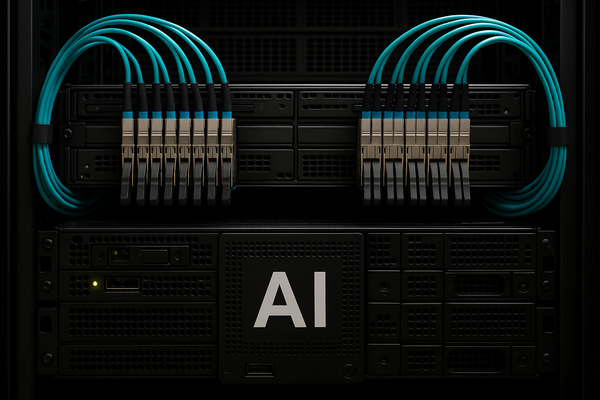
Data first: Ciena announced the acquisition of Nubis for $270,000,000 and Bank of America has lifted Ciena’s price target to $155 from $135 (a $20, or +14.8% move), signaling that a $270M strategic buy and a two‑digit target upgrade are reshaping investor expectations for network optics and AI connectivity.
Ciena’s $270M Nubis deal matters because the technology being folded in addresses the bottleneck that hyperscalers are explicitly paying to remove. Credo Technology’s recent product rollouts — a Bluebird DSP positioned for 1.6 terabits per second (1.6Tbps) optical links and a 224G PAM4 SerDes IP on TSMC N3 — show the same economics at work: vendors are monetizing higher line rates (1.6Tbps) and advanced SerDes nodes (224G) that cut power per gigabit and raise effective gross margins.
Credo’s technology cadence is concrete: the company publicized a 1.6Tbps target for next‑generation optical transceivers and unveiled 224G SerDes IP on TSMC’s N3 process. William Blair initiated coverage of Credo on September 18 with a Buy rating, marking a clear analyst bite: initiation date 9/18, technical capability 224G, and marketing position 1.6Tbps — three numerical signals investors can track for product adoption.
Storage is the other half of this trade. Western Digital closed recent sessions at $110.25 per share, is up roughly +135% year‑to‑date, and has seen price‑target action: Cantor Fitzgerald nearly doubled its target — raising it from $85 to $160 — a move that implies a +88% target re‑rating and an implied upside of about +45% from $110.25 to $160. Those are hard numbers that quantify how investors are valuing storage exposure to AI infrastructure.
The linkage is straightforward and measurable: companies selling higher‑bandwidth optics (1.6Tbps), ultra‑high‑speed SerDes (224G), and dense storage racks are benefiting simultaneously. Super Micro Computer’s systems validated for NVIDIA GB300 NVL72 deployments and Ciena’s $270M acquisition both underscore where hyperscalers are spending capital — on end‑to‑end throughput upgrades and rack‑level density that move exabytes per month through 1.6Tbps trunk links.
Look at the analyst math. Bank of America’s move on Ciena (PT +$20 to $155) and Cantor’s move on Western Digital (PT +$75 to $160) are explicit price‑target signals: $20 and $75 are not market noise; they are conviction increments. If Ciena’s $155 target is hit, that target represents a +14.8% rise from the prior $135 target; if WDC’s $160 target is hit from $110.25, that is a +45.1% upside for shareholders who believe the AI storage cycle persists.
Execution risk is measurable too. Ciena spent $270M to buy Nubis — a sum small enough to be quickly accretive if Nubis delivers just a few percentage points of incremental gross margin across Ciena’s optical portfolio, but also large enough that integration timelines (weeks to quarters) matter. Credo’s Bluebird DSP and 224G SerDes IP are product‑level numbers investors should track on adoption cadence: announcements (1.6Tbps, 224G) translate into design wins that typically show up in revenue within 2–4 quarters for networking silicon suppliers.
Valuation versus operational momentum: Western Digital’s +135% YTD return and Cantor’s $160 target imply strong multiple expansion already priced in. The gap between WDC’s current $110.25 and $160 PT is +45%, while WDC’s YTD +135% shows how quickly expectations can compress or expand. For traders, that combination creates pockets for event‑driven strategies: follow price‑target revisions ($85 -> $160) and daily prints around $110.25 for entry/exit levels.
Where the numbers create actionable signals: quantify order flow and product milestones. For Credo, the critical metrics will be announced design wins for 1.6Tbps links and license revenue tied to 224G SerDes IP; both are concrete data points investors should look for in upcoming press releases and earnings slides. For Ciena, the $270M Nubis integration should produce tangible line‑item impacts to optical‑segment revenue and gross margin in the next two quarterly reports — watch for a change of at least a few percentage points in segment margins tied directly to Nubis product line rollouts.
Shorter‑horizon trading checklist with numbers: (1) watch CIEN price moves around the BofA $155 target (track intraday volume spikes >2x average), (2) monitor CRDO press releases for 1.6Tbps design‑win announcements (count wins announced per quarter: 0, 1, 2+), and (3) use WDC’s Cantor target delta ($85 -> $160) as a volatility anchor — plan entries near $100–$115 and trim into strength toward $160 if momentum sustains (implied upside +45% from $110.25).
Finally, macro math: hyperscaler spending on AI hardware is pushing link‑level throughput and storage density into numbers that matter — 1.6Tbps links, 224G SerDes, GB300 NVL72 racks and multi‑exabyte storage footprints. When a strategic buyer like Ciena pays $270M for an asset that addresses those needs and analysts lift price targets by $20–$75, those are measurable, numerically driven signals that capital markets are re‑rating the entire supply chain.
For institutional investors and active traders, the takeaways are numeric and immediate: track Ciena around its $155 Bank of America target and the $270M Nubis integration; track Credo around its 1.6Tbps and 224G product adoption milestones and William Blair’s Buy initiation (9/18); and treat Western Digital’s $110.25 quote, +135% YTD run and Cantor target of $160 as the market’s current valuation battleground where a +45% implied upside coexists with elevated multiple risk.












